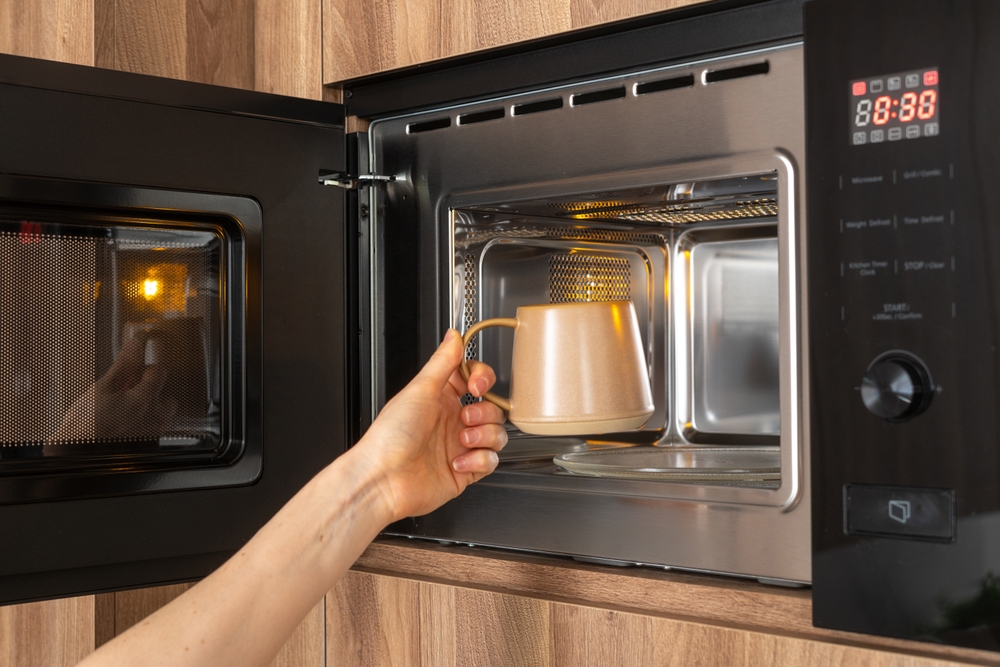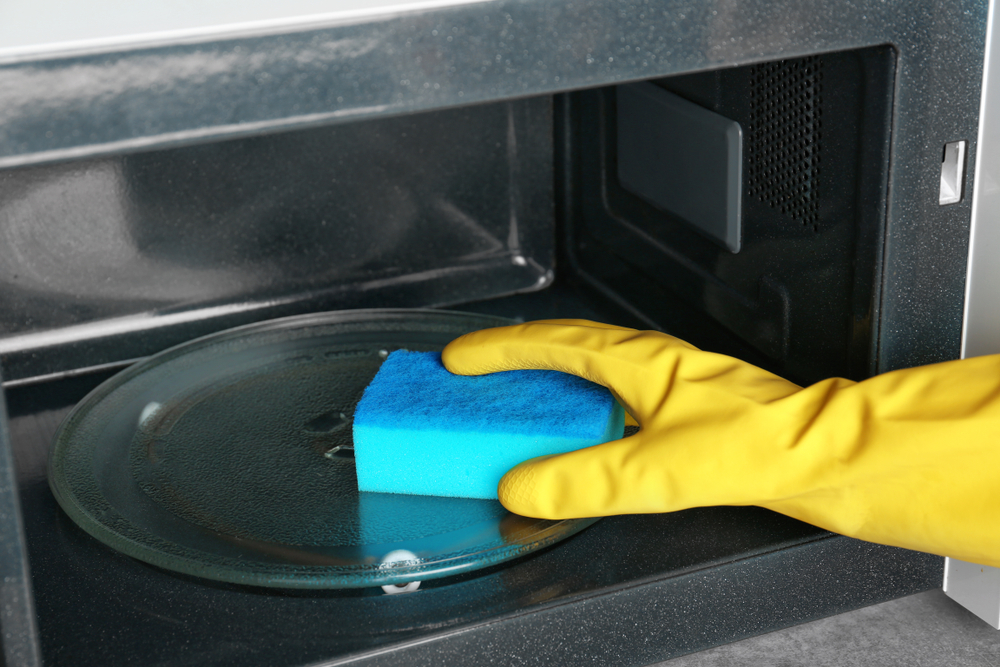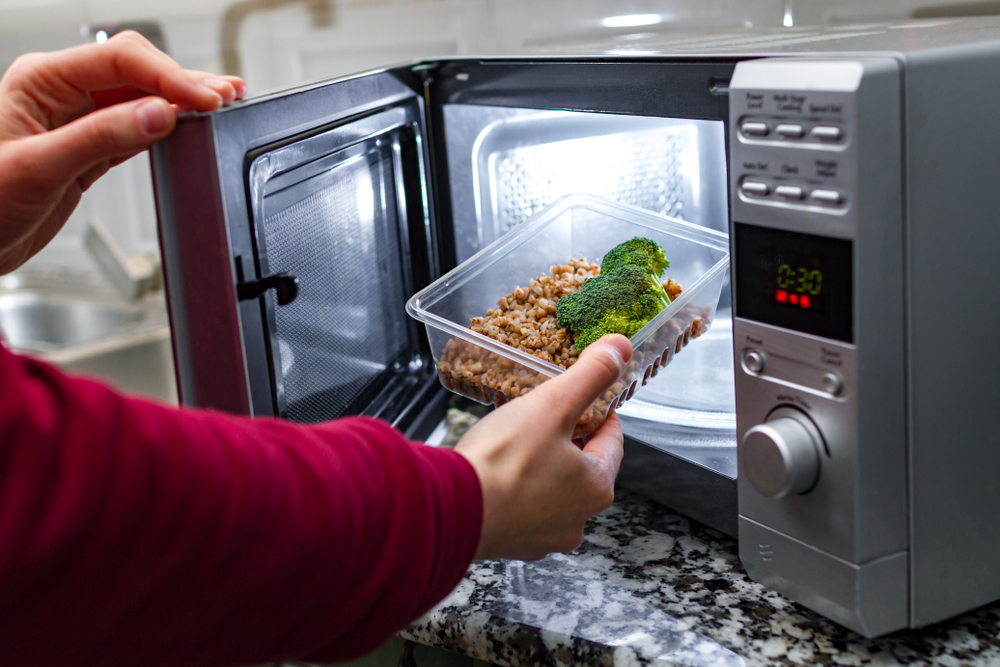The microwave is one of the most common kitchen appliances, yet most people have never learned how to use it properly. It is often treated as a quick-fix machine for reheating leftovers or making popcorn, but this incredible invention can do far more. The problem is that many everyday habits actually limit its potential and sometimes even make food less safe. From the containers you choose to the way you heat liquids, small mistakes can add up. Understanding how to use a microwave correctly can save time, improve taste, and make your meals healthier.
Using the Wrong Containers Every Time
One of the most widespread mistakes is heating food in containers that are not microwave safe. Many people use cheap plastic takeout boxes, thin plastic wraps, or even metal pans without realizing the risks. Plastic that is not microwave safe can warp, melt, and potentially release harmful chemicals into food. Metal is even worse since it reflects microwaves, creating sparks that can damage the appliance or start a fire. The best choice is always microwave-safe glass or ceramic. These materials heat evenly, do not release toxins, and are durable. Even when using plastic, only those labeled microwave safe should ever go inside. Making this switch can improve both safety and food quality.
Believing Full Power Is Always Best
Another mistake is keeping the microwave on the highest power setting for everything. While full power is fine for boiling water or cooking certain items quickly, it does not work well for most meals. Lower power settings allow food to heat more evenly and gently. For example, reheating a casserole or pasta at half power prevents the outside from drying out while the inside stays cold. Defrosting at lower power is also more effective because it avoids cooking parts of the food while other areas remain frozen. Learning to use different power levels is one of the easiest ways to improve your microwave results.
Leaving Food Uncovered While Heating
A plate of uncovered food in the microwave often comes out dry and unappealing. Covering food with a microwave-safe lid, a glass cover, or even a damp paper towel traps steam inside. This moisture keeps food from drying out and helps it reheat evenly. It also prevents splattering, which keeps the microwave clean and reduces odors. For foods like rice, vegetables, and bread, covering them makes the difference between a rubbery texture and a fresh one. Even simple leftovers taste better when they are covered properly during heating.

Worrying About Standing Too Close
A common belief is that standing near the microwave while it runs is unsafe. In reality, modern microwaves are built with protective shielding that prevents radiation from escaping. The energy stays inside and only interacts with the food. The real mistakes are not about standing near it but about how food is handled inside. Burns from overheated dishes, superheated liquids, and poor heating habits are the actual dangers. Standing close does not put you at risk, but not learning the correct cooking methods can.
Forgetting to Stir or Rotate Food
One of the reasons microwaves have turntables is because the waves do not always heat food evenly. Placing food in the center without moving it or stirring often leaves hot and cold spots. Soups, stews, and thick sauces in particular need stirring halfway through. Even with a turntable, pausing the cycle to stir helps distribute heat and ensures the whole dish is safe to eat. Skipping this step is one of the main reasons people complain about uneven heating. It is a small effort with a big payoff.
Thinking the Microwave Is Only for Leftovers
For many households, the microwave is only used to warm yesterday’s dinner or make popcorn. This is a mistake that limits the potential of the appliance. Microwaves can steam vegetables quickly while preserving more vitamins than boiling. They can melt chocolate or butter evenly without burning. They can cook fish fillets gently, leaving them moist and flavorful. Potatoes, scrambled eggs, mug cakes, and even homemade chips can be made in minutes. Learning these techniques expands the role of the microwave beyond reheating and saves time compared to traditional cooking.
Overheating Water and Liquids
Heating water or other liquids in the microwave may seem simple, but doing it the wrong way can be dangerous. If heated too long, water can become superheated. This means it goes beyond boiling temperature without bubbling. When disturbed, it can erupt suddenly and cause burns. A safer method is to heat liquids in short bursts and stir between intervals. Placing a wooden stick or microwave-safe spoon in the cup also helps break surface tension, reducing the risk of explosions. Knowing this technique can prevent serious accidents in the kitchen.
Ignoring Resting Time After Heating
Food does not stop cooking immediately when the microwave beeps. Heat continues to spread for a short time, which is why letting food rest is important. Giving dishes one or two minutes after heating allows temperatures to even out. This reduces the risk of biting into a cold center while the edges are scalding hot. It also ensures that meat, poultry, and fish finish cooking safely. Skipping the resting period is a small mistake that can affect both taste and safety.
Forgetting to Cover Oily Foods
Greasy foods like bacon, cheese, and certain meats tend to splatter in the microwave. Many people heat them uncovered, leading to a greasy mess inside. Not only does this make cleaning harder, but it also increases the chance of burns when opening the door. Covering oily foods with a microwave-safe lid or paper towel prevents splashes while still allowing steam to escape. This habit keeps the microwave cleaner and food safer.
Defrosting Food Improperly
Another mistake is trying to defrost frozen food on full power or leaving it on the counter. Full power often cooks the edges while leaving the inside frozen solid. Leaving food at room temperature for hours allows bacteria to grow. The microwave’s defrost function uses lower power to thaw food gradually. Flipping or stirring halfway through makes it more effective. This method keeps food safe while preparing it for cooking.
Placing Food in the Center of the Turntable
Many people assume food should go directly in the center of the plate. In reality, this often leads to uneven heating because microwaves distribute energy more effectively toward the edges. Placing food slightly off-center allows it to move through hotter zones as the turntable spins. This simple adjustment results in more consistent heating and reduces the need to stir or reheat.
Forgetting to Clean the Microwave Regularly
Food splatters and grease build up inside the microwave over time. This not only creates odors but also absorbs some of the microwave energy, making it less efficient. Cleaning it regularly improves performance and hygiene. A simple method is to heat a bowl of water with lemon slices or vinegar for a few minutes. The steam loosens grime and makes it easy to wipe away. Keeping the microwave clean ensures it works properly and does not transfer old odors to new meals.

Overloading the Microwave with Too Much Food
Stuffing the microwave full of multiple plates or oversized containers prevents heat from circulating properly. Overloading leads to uneven results and increases cooking time. Microwaves are designed for small to medium portions, not full feasts. Heating in smaller batches ensures better results and avoids straining the appliance. When reheating multiple plates, staggering the heating process works better than cramming everything inside at once.
Forgetting the Importance of Steam Vents
When covering food with a lid or plastic wrap, many people forget to leave a vent. Trapping steam completely can cause pressure to build and make the cover pop off or even cause burns. Leaving a small gap or using covers designed with vents prevents this. Steam circulation also improves heating and avoids soggy textures. It is a simple detail that makes a big difference in both safety and quality.
Using Plastic Wrap Incorrectly
Microwaving food with plastic wrap directly touching it is another common mistake. Even microwave-safe plastic wrap should not press against fatty or oily foods, as the heat can make it melt into the food. The correct method is to leave space between the wrap and the dish, creating a tent shape. This keeps moisture in while preventing contact. It also avoids chemical transfer and ensures the food retains its flavor.
Not Exploring Microwave-Specific Cooking Tricks
The microwave has many hidden tricks that most people never use. Peeling garlic becomes easier by microwaving cloves for just a few seconds. Stale bread can be revived by wrapping it in a damp towel and microwaving briefly. Citrus fruits like lemons and limes release more juice after a quick spin in the microwave. Even homemade chips can be made by slicing potatoes thinly, seasoning them, and cooking them in small batches until crispy. These tricks prove that the microwave is more versatile than many realize.
Conclusion
The microwave is often underestimated and misused, yet it is one of the most valuable tools in the kitchen. From cooking food unevenly to using the wrong containers, common mistakes keep people from enjoying its full benefits. By covering food properly, adjusting power settings, defrosting correctly, and cleaning regularly, the microwave becomes safer and more effective. It can do more than heat leftovers, it can steam vegetables, cook fish, melt ingredients, and even bake small portions in record time. With the right habits, this everyday appliance can transform the way you cook.
Disclaimer: This article was created with AI assistance and edited by a human for accuracy and clarity.

